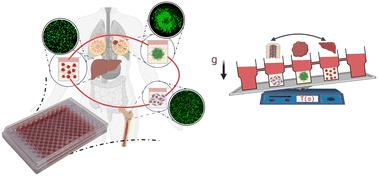Our official English website, www.x-mol.net, welcomes your
feedback! (Note: you will need to create a separate account there.)
A gravity-driven tissue chip to study the efficacy and toxicity of cancer therapeutics
Lab on a Chip ( IF 6.1 ) Pub Date : 2024-10-24 , DOI: 10.1039/d4lc00404c Pouria Rafsanjani Nejad, Astha Lamichhane, Prasiddha Guragain, Gary Luker, Hossein Tavana
Lab on a Chip ( IF 6.1 ) Pub Date : 2024-10-24 , DOI: 10.1039/d4lc00404c Pouria Rafsanjani Nejad, Astha Lamichhane, Prasiddha Guragain, Gary Luker, Hossein Tavana

|
Tissue chip and organs-on-chip technologies have emerged as promising tools in preclinical studies. In oncology, this is driven by the high failure rates of candidate drugs in clinical trials mainly due to inadequate efficacy or intolerable toxicity and the need for better predictive preclinical models than those traditionally used. However, the intricate design, fabrication, operation, and limited compatibility with automation limit the utility of tissue chips. To tackle these issues, we designed a novel 32-unit tissue chip in the format of standard 96-well plates to streamline automation, fabricated it using 3D printing, and leveraged gravity-driven flow to bypass the need for external flow devices. Each unit includes three interconnected tissue compartments that model liver, tumor, and bone marrow stroma. The focus on liver and bone marrow stroma was due to their respective roles in drug metabolism and disturbances to the bone marrow niche from off-target toxicity of chemotherapies. We analyzed flow patterns, mixing, and oxygen transport among and within the compartments through finite element simulations and demonstrated the utility of the tissue chip to study the efficacy of commonly-used cytotoxic cancer drugs against tumor cells and their toxicity toward liver and bone marrow cells. The ability to simultaneously study drug efficacy and toxicity in high throughput can help select promising therapeutics in early stages of drug discovery in preclinical studies.
中文翻译:

一种重力驱动组织芯片,用于研究癌症治疗的疗效和毒性
组织芯片和器官芯片技术已成为临床前研究中很有前途的工具。在肿瘤学领域,这是由于候选药物在临床试验中的高失败率所驱动的,主要是由于疗效不足或无法耐受的毒性,以及需要比传统使用的模型更好的预测性临床前模型。然而,复杂的设计、制造、操作以及与自动化的有限兼容性限制了组织芯片的实用性。为了解决这些问题,我们设计了一种标准 96 孔板格式的新型 32 单元组织芯片来简化自动化,使用 3D 打印制造,并利用重力驱动流动来绕过对外部流动设备的需求。每个单元包括三个相互连接的组织隔室,用于模拟肝脏、肿瘤和骨髓基质。对肝脏和骨髓基质的关注是由于它们在药物代谢中各自的作用以及化疗的脱靶毒性对骨髓生态位的干扰。我们通过有限元模拟分析了隔室之间和隔室内的流动模式、混合和氧气运输,并证明了组织芯片在研究常用细胞毒性癌症药物对肿瘤细胞的疗效及其对肝脏和骨髓细胞的毒性方面的效用。同时高通量研究药物疗效和毒性的能力有助于在临床前研究中药物发现的早期阶段选择有前途的疗法。
更新日期:2024-10-24
中文翻译:

一种重力驱动组织芯片,用于研究癌症治疗的疗效和毒性
组织芯片和器官芯片技术已成为临床前研究中很有前途的工具。在肿瘤学领域,这是由于候选药物在临床试验中的高失败率所驱动的,主要是由于疗效不足或无法耐受的毒性,以及需要比传统使用的模型更好的预测性临床前模型。然而,复杂的设计、制造、操作以及与自动化的有限兼容性限制了组织芯片的实用性。为了解决这些问题,我们设计了一种标准 96 孔板格式的新型 32 单元组织芯片来简化自动化,使用 3D 打印制造,并利用重力驱动流动来绕过对外部流动设备的需求。每个单元包括三个相互连接的组织隔室,用于模拟肝脏、肿瘤和骨髓基质。对肝脏和骨髓基质的关注是由于它们在药物代谢中各自的作用以及化疗的脱靶毒性对骨髓生态位的干扰。我们通过有限元模拟分析了隔室之间和隔室内的流动模式、混合和氧气运输,并证明了组织芯片在研究常用细胞毒性癌症药物对肿瘤细胞的疗效及其对肝脏和骨髓细胞的毒性方面的效用。同时高通量研究药物疗效和毒性的能力有助于在临床前研究中药物发现的早期阶段选择有前途的疗法。































 京公网安备 11010802027423号
京公网安备 11010802027423号